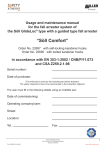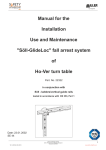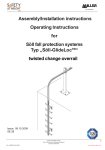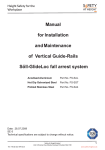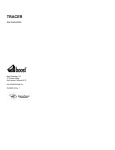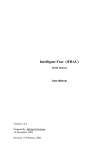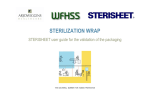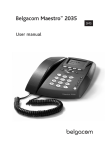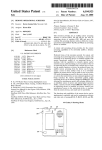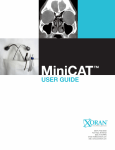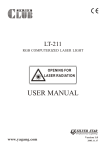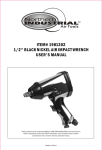Download Söll GlideLoc Demountable Ladder installation and user manual
Transcript
Manual for Installation and Maintenance of De-Mountable Yspar Ladders Aluminium Part-No. YAL-....... Date: 25.06.2008 SE 22 Tel: +44(0)161 446 5615 Safety At Height Limited Unit 1 Pennine View, Marple, Stockport Cheshire, SK67JW 1 www.safety-height.co.uk Table of contents A General 3 B Installation 5 C Inspection, Approval and Maintenance 16 D Bolt connections/securing of bolts 17 E Use of the ladder 18 F Checklist 20 These instructions are protected by copyright! They may not be reproduced and distributed in any ways/ by any means without prior written consent of the author according to Articles 16 and 17 of the German Copyright Act. Sperian Fall Protection Deutschland GmbH & Co. KG will prosecute any violations against this under Article 106 of the German Copyright Act. Tel: +44(0)161 446 5615 Safety At Height Limited Unit 1 Pennine View, Marple, Stockport Cheshire, SK67JW 2 www.safety-height.co.uk A General A 1. Anyone working with or on SÖLL fall protection systems in accordance with EN 353/part 1 must be familiarized with these instructions prior to using the system. Use which is not in accordance with these instructions constitutes a risk to human life! A 2. The operator of the fall protection system must ensure that these instructions are either • retained in a dry and secure condition at the installation or • retained by the operator, whereby he or she must ensure that the user is aware of the storage location of these instructions and that the documents are accessible at all times. A 3. If requested, the plant operator must present these instructions to the manufacturer of the fall protection system (Sperian Fall Protection Deutschland GmbH & Co. KG or a dealer authorized by the same). A 4. The SÖLL fall protection system must be used in accordance with the instructions for the relevant SÖLL fall arrester. A 5. The fitment and use of SÖLL accessories to such fall protection systems must strictly adhere to the relevant instructions for the fitment and use thereof. A 6. In case of the use of further personal protective equipment, relevant instructions must be followed. A 7. National regulations on accident prevention and use of safety equipment for construction work must be adhered to. A 8. Söll fall protection systems may only be fitted and used with original Söll components/ elements. The combination with non-original components/elements may influence the safety of SÖLL fall protection systems. In such cases, Sperian Fall Protection Deutschland GmbH & Co. KG and a dealer authorized by the same refuse to accept product liability. In addition, such systems are not properly approved and authorized since SÖLL fall protection systems are tested, approved and authorized as complete systems. Full liability will therefore rest with the operator. This product and it's components are patented. The combination with components not originated by Söll may therfore not be used. Sperian Fall Protection Deutschland GmbH & Co. KG will prosecute any violations against this. A 9. The check list (see Section F) must be fully and correctly compiled by the chief engineer of the installing company by means of an indelible pen. A 10. Before and during the use of the installed fall protection system, the system must be visibly inspected to ensure that it is operating properly. (refer to clause C) A 11. While fastening clamps, the bars may deform a little. This may cause breaks to the layer of zinc. This has no adverse effect to safety, durability or corrosion resistance. Tel: +44(0)161 446 5615 Safety At Height Limited Unit 1 Pennine View, Marple, Stockport Cheshire, SK67JW 3 www.safety-height.co.uk A 12. With a weight of 100 kg and fall factor 2 situation (worst-case scenario) the height required under the feet of the user is at least 2 m. A 13. The system has been tested and approved by "Stelle 0158: DEKRA EXAM GmbH, Zertifizierungsstelle, Dinnendahlstraße 9, 44809 Bochum. Tel: +44(0)161 446 5615 Safety At Height Limited Unit 1 Pennine View, Marple, Stockport Cheshire, SK67JW 4 www.safety-height.co.uk B Installation Caution: Before, during and after fitting, persons must always be protected against falls from the ladder, the platform or the roof, using appropriate protective equipment prescribed by the local safety regulations. In addition, every component (such as ladder section, bracket, tools) must be protected from falling from the building or the platform during fitting and dismounting! Two basic types of ladders are supplied: Type 1: Single ladder (may not be put together) Type 2: Ladder which may be put together Type 1, single ladder: length of ladder in accordance with specification The ladder set consists of: 1 ladder section 1 male bracket, complete 1 female-clamp, complete 1 male-lock-bracket, complete 1 safety clamp, complete 1 bottom end-stop 1 rigid end-stop Part-No. YAL-..... Part-No. 10779 Part-No. BES-OA Part-No. 14981 Part-No. BES-MA Part-No. 14666 Part-No. 11634 For the ladder length of more than 1960 mm, additional 1 male-bracket, complete Part-No. 14982 1 female-clamp, complete Part-No. BES-OA Type 1 up to 1960 mm Type 1 from 1960 mm Tel: +44(0)161 446 5615 Safety At Height Limited Unit 1 Pennine View, Marple, Stockport Cheshire, SK67JW 5 www.safety-height.co.uk Type 2 joinable ladder length of ladder sections to specification The ladder set consists of: 1 footer (longest piece) 1 male-bracket, complete 1 female-clamp, complete 1 male-lock-bracket, complete 1 female-clamp, complete 1 bottom end-stop Part-No. YAL-..... Part-No. 10779 Part-No. BES-OA Part-No. 14981 Part-No. BES-MA Part-No. 14666 For the ladder length of more than 1960 mm, additional 1 male-bracket, complete Part-No. 14982 1 female-clamp, complete Part-No. BES-OA possibly 1 or more central sections Per section (max. ladder length 1960 mm): Part-No. YAL-..... 1 male-bracket, complete Part-No. 10779 1 male-bracket, complete Part-No. 14982 2 female-clamps, complete Part-No. BES-OA 1 header (max. 1960 mm) 1 male-bracket, complete 1 male-bracket, complete 2 female-clamps, complete 1 rigid end-stop Part-No. YAL-..... Part-No. 10779 Part-No. 14982 Part-No. BES-OA Part-No. 11634 Type 2 Before the fitting, all ladder components of type 2 ladders should be laid out in the order of fitting. Attention should be paid to differing overhangs of fixing brackets on tapered or shouldered masts. Tel: +44(0)161 446 5615 Safety At Height Limited Unit 1 Pennine View, Marple, Stockport Cheshire, SK67JW 6 www.safety-height.co.uk B 1. Equipment required for easy mounting: 2 open wrenches, SW 19 2 fall arresters, 2 full body harnesses according EN 361 Min. 1 additional safety lanyard according to EN 354/355 with energy absorber und 1 separates Halteseil nach EN 358 for each person to protect the mounting person against falls from height during the installation. B 2. Personnel required for installation: two persons B 3. Components must be handled carefully. Ladder sections must not be thrown. B 4. Before installation, ladder sections must be cleaned from dirt - in particular on connecting surfaces joints. They should not come into contact with cement, mortar or similar substances. Remnants of mortar must be wiped off immediately. Especially the sliding surfaces for the fall arrester on the inside and outside of the guide-rail must be free of dirt. B 5. Damaged parts may neither be used nor repaired but must be replaced by new ones. B 6. Minimum bolt dimensions for the installation of ladders: The minimum bolt size is M 12. According to DIN 18799-3, the bolts used on chimneys must be of stainless steel A 4 DIN ISO 3506-1, at least M 20 or, when used for anchoring, 1.25 m M 12 bolts. Ordering of the mounting brackets must be based on the minimum dimensions. B 7. We specifically stress that only those dowels may be used which are permitted by site inspection engineers. B 8. For concrete structures we recommend the use of injection anchor or undercut dowels (such as Hilti, Fischer, UPAT or Liebig); follow technical instructions given by the manufacturer. In case of installation on brick wall constructions we recommend you to consult the responsible design engineer for an approval in each specific case. Use the following instructions to calculate the anchoring forces. Always select the least favourable loading result. • Extreme influences (fall accident): In case a load F4 = 6 kN acting along the centre of the ladder is to be assumed. This load may be distributed over four mounting brackets (if available). • Varying influences (loads appearing during use): In this case it shall be assumed that loads F2 = 1,5 kN appears at a distance of 30 cm in front of the ladder centre and in distances of 2 m from each other influence the installation. Also consider a horizontal load F5 = 0,3 kN influencing the attachment at the most unfavourable location. Tel: +44(0)161 446 5615 Safety At Height Limited Unit 1 Pennine View, Marple, Stockport Cheshire, SK67JW 7 www.safety-height.co.uk B 9. Warning! The proper functioning of the fall arrester can only be guaranteed in that part of the guiding rail that is located between gated end stops as well as during proper use. Installation or dismounting of the fall arrester on the guiding rail as well as moving beyond the gated end stop may only be done in a safe position (e.g., firm ground, safe platform, safety rope in accordance with EN 354/355). Fig. 1 B 10. Erection staff can during the installation secure themselves by using: ØSafety lanyard (acc. to EN 354/355) connected to the center rail to the ladder under the highest situated properly secured mounting bracket ØThe carabiner of a safety lanyard (EN 354/355) is connected to a mounting bracket ØSupport lanyard (EN 358) routed around the centre rail of the ladder ØThe use of an external anchorage point Fig. 1 EN 354/355 Tel: +44(0)161 446 5615 EN 358 Safety At Height Limited Unit 1 Pennine View, Marple, Stockport Cheshire, SK67JW 8 www.safety-height.co.uk Attention! As a rule, ladder brackets are attached in the factory. If this was not done at the request of the customer or if local conditions should request changes in bracket positions, every ladder section must be equipped with at least two fixing brackets. The outer fixing brackets must be installed less than 525 mm from the (upper or lower) end of the ladder section (fig. 2). For ladder length of 2,520 mm three fixing brackets per ladder section must be installed! Any bolt connections must be tightly fastened, see also Section D. Fig. 2 Tel: +44(0)161 446 5615 Safety At Height Limited Unit 1 Pennine View, Marple, Stockport Cheshire, SK67JW 9 www.safety-height.co.uk B 11. Before fitting it has to be examined where mast brackets can be installed. B 12. Fig. 3/4 After having fitted the lowest bracket to the first ladder section (also called footer) the mast clamp is installed as shown in the drawing. Adjust the height where the clamps should be installed, in such a way that the next clamp can be installed at a maximum distance of 1.680 mm without encountering any barriers (such as an atenna fixing device). Fig. 3 Tel: +44(0)161 446 5615 Fig. 4 Safety At Height Limited Unit 1 Pennine View, Marple, Stockport Cheshire, SK67JW 10 www.safety-height.co.uk Fig. 5 B 13. Attach the ladder and determine the next point of attachment (max. of 1,680 mm above the first one). Fit ladder bracket. B 14. Install the appropriate clamp with attached ladder by moving the clamp upwards until stopped by the ladder bracket. Tighten the bolts of the clamp. Fig. 5 Tel: +44(0)161 446 5615 Safety At Height Limited Unit 1 Pennine View, Marple, Stockport Cheshire, SK67JW 11 www.safety-height.co.uk Fig. 6 Attention! The stop pin (2.1) attached to the safety clamp (2.0) must automatically lock into place when the lower ladder section is attached to the ladder bracket (3.0). When raising the ladder section it must be impossible to remove the ladder section from the ladder brackets. All clamps/brackets must be in alignment otherwise the ladder can not be properly installed or dismounted! Make sure that the ladder may be easily fitted and dismounted! If this is not the case, readjust clamps. It must be ensured that locked ladder brackets remain on mast clamps in a flat way. It must also be ensured that there are no barriers (such as antennae or cables) which prevent proper fitting and dismounting of the ladder. Fig. 6 Tel: +44(0)161 446 5615 Safety At Height Limited Unit 1 Pennine View, Marple, Stockport Cheshire, SK67JW 12 www.safety-height.co.uk B 15. Torque ranges: When tightening mounting screws in steel quality 8.8 used in combination with tooth lock washers the following tightening torque range is recommended: Screw size: M 10 20 Nm M 12 25 Nm M 16 60 Nm M 20 120 Nm When tightening mounting screws in stainless steel quality 1.4571 in combination with Söll supplied auto-locking nuts (DIN 985) the following torque range is recommended: Screw size: M 10 40 Nm M 12 45 Nm M 16 85 Nm M 20 Fig. 7 a/b B 16. If the „bottom end-stop“ (4.0) was not attached in the factory it is bolted through the rectangular slot (1.4) of the central spar (1.1) directly below the second „pin stop“ (1.2) onto the lowest ladder section (also called footer). If there is a recess, screw the "Climbing lock below" (4.0) from behind through the square perforation (1.4) of the centre spar (1.1) using the ladder such that the "Climbing lock below" (4.0) is minimum 240 mm and maximum 590 mm over the recess (1.3). Note: The "Climbing lock below" must be mounted such that the foldable locking bar (4.1) is to the right of the centre spar. Fig. 7a Tel: +44(0)161 446 5615 Fig 7b Safety At Height Limited Unit 1 Pennine View, Marple, Stockport Cheshire, SK67JW 13 www.safety-height.co.uk Attention: In order to prevent the incorrect installation of the fall arrester, it should only be installed after the fitment of the bottom end-stop. Fig. 8 Attention! For type 2 ladders (page 5) the fall arrester may not be moved past the upper gated end stop (5.0) if the next ladder section has not been installed completely and attached to the other ladder section by means of the connecting pin (6.0). During installation work the fall arrester may never be moved past the last fixing bracket which has been firmly anchored to the structure (see also section D!). Fig. 8 Tel: +44(0)161 446 5615 Safety At Height Limited Unit 1 Pennine View, Marple, Stockport Cheshire, SK67JW 14 www.safety-height.co.uk B 17. The next ladder section which is to be fitted should remain against the mast and inserted vertically into the ladder section which has already been fixed. Follow the instructions on page 13 and the figures on pages 4 and 5 always taking into account the relevant type of ladder. Use additional equipment against falls (see Section B 5 and 6)! Fig. 9 B 18. If not attached in the factory, the rigid end-stop (8.0) is fitted in the first rectangular slot (1.4) below the last pin stop (1.2) of the guiding rail at the upper end of the climbing path (or header). The rigid end-stop must be installed in such a way that both of its sides (8.1) embrace the rail from the front. The rigid end-stop (8.0) prevents the fall arrester from accidental sliding out of the rail. Fig. 9 B 19. Keep ladders in vertical line at all times during fitting. Tel: +44(0)161 446 5615 Safety At Height Limited Unit 1 Pennine View, Marple, Stockport Cheshire, SK67JW 15 www.safety-height.co.uk C Inspection, Approval and Maintenance (see also check list on pages 20-22) C 1. It must be ensured that ladders are in a vertical position. All clamps must be in alignment. Ladder joints may not show any gaps. C 2. Ladder sections must be easily inserted and removed. C 3. For ladder sections of 2,250 mm at least three fixing brackets must be installed. C 4. When inserting the first ladder section, the corresponding lower bracket must lock into the stop bolt (Fig. 6/detail 2.1). C 5. When joining ladder sections the connection pin(Fig. 8/detail 6.0) must lock into the connecting element and thus secure the upper ladder section against unintentional lifting. C 6. All screw connections have to be properly tightened and secured against unintended opening (refer to section D). Even bolts pre-assembled in the factory must be checked and secured where appropriate. C 7. Gated and rigid end-stops must be inspected. They must be safely fastened and locked against loosening. The locking lever of the "Climbing lock below" must go back to its initial position automatically. The end stop pin (Fig. 8/detail 5.0) below the section connector must automatically block the passing of the fall arrester. C 8. All locking pins (of clamps and connecting straps) must fall into their counterparts independently and secure them against unintentional removal. Attention: For reasons of safety ladder sections should not be repaired without consulting qualified personnel. Ladders which were mechanically damaged, for example, after a fall from heights or by throwing, must be exchanged. C 9. Warning: The connectiong pin (Fig. 8/Detail 6.0) as well as the stop bolt (Fig. 6/Detail 2.1) may slightly commode in heavy corrosive environment (eg. sea water). This kind of corrosion does not influence the stability of the product, but it may influence its function. Therefore the functionality of these elements has always to be checked before use by pulling out and releasing them. If they do not automatically resume their neutral position apply penetrating oil and try again. If this does not help, remove the ladder section from use. Tel: +44(0)161 446 5615 Safety At Height Limited Unit 1 Pennine View, Marple, Stockport Cheshire, SK67JW 16 www.safety-height.co.uk C 10. Ask an expert to inspect the fall protection devices with fixed guides regularly as per requirement, however at least once every 12 months, by taking the manufacturer’s specifications as well as statutory regulations, usage and operating conditions into account. Note: If the device has not been used for a period longer than one year, ask an expert to inspect the device before reusing it. C 11. Fall arresters must be examined by an expert at least once a year and after every fall from a height. In such cases refer to the relevant instructions. C 12. Check the proper condition and functioning of all elements of the climbing protection system before and during use. C 13. At every location of a fall arrest system where a fall arrester may be connected or disconnected to the system a permanent sign board with the following information shall be displayed: - Year of manufacture System manufacturer´s or importer´s name Type of fall system e.g. DIN EN 353-1 "Anyone using the system shall use a full body safety harness and an appropriate fall arrester" Note: Sign Boards may consist of stamped aluminium plates. Note: Installer shall agree with system owner about the necessary quantity of fall arresters (e.g. Comfort) needed. Every system shall include at least two fall arresters. D Bolt connections/securing of bolts At use of hot dip galvanised screws the troth washer ensures satisfactory securing of the screw/nut connection. At use of stainless steel screws self-locking nuts (nyloe or similar) shall be used. Tel: +44(0)161 446 5615 Safety At Height Limited Unit 1 Pennine View, Marple, Stockport Cheshire, SK67JW 17 www.safety-height.co.uk E Use of the ladder Note: Particular attention is required when ascending and descending the first 2 m of ladder, as it may not be possible to prevent the user from falling to the ground. Both before and during use, consideration should be given to how rescue operations can be performed safely and effectively. A fall protection device according to EN 353 Part 1 should only be used by persons who • have been trained and/or are otherwise proficient in its use, or • are under the direct supervision of a person who has been trained and/or is otherwise proficient in its use. Warning: The fall arrest system must not be used if defects have been noted or in case of doubts as to its proper function. Before further use an inspection by a competent person is needed or the defective parts have to be replaced. Warning! The person using this ladder must always protect himself against falls from heights with proper equipment. Always secure ladder sections against falls by means of a rope! E 1. Before fitment all ladder sections should be laid out in the order of their fitment. E 2. Insert the first ladder section (or footer) (figures 3 and 4) and lock it into the locking bracket (fig. 6). Lift ladder and thus check locking. Insert fall arrester and attach to safety harness. Ladder sections must be installed only when using the fall arrester. Warning! The fall arrester may not be moved past the gated end stop (fig. 8, detail 5.0) at the upper part of the lower ladder section unless the next ladder section has been firmly installed. Warning: The end stop (Fig. 8/detail 5.0) located at the upper end of the lower section must not be passed with the fall arrester, unless the next section is mounted and secured in place. E 3. Add the next ladder section and secure with connecting pin (fig. 8, detail 6.0) of section connector. Check again by lifting whether the section locked properly. Only then open the gated end stop (fig. 8, detail 5.0) by pulling the safety pin at the back of the ladder and move the fall arrester to the next ladder section. E 4. The ladder with rigid end-stop (fig. 9) is the last piece to be installed on the climbing path. Dismounting of the ladder: Same steps E 1 to E 5 in reversed order. Tel: +44(0)161 446 5615 Safety At Height Limited Unit 1 Pennine View, Marple, Stockport Cheshire, SK67JW 18 www.safety-height.co.uk Warning! Before removing the relevant upper ladder section the fall arrester must be moved below the gated end stop (fig. 8, detail 5.0) of the next lower ladder section! Otherwise the fall arrester might be removed unintentionally and thus lead to the risk of a fall from a height. Tel: +44(0)161 446 5615 Safety At Height Limited Unit 1 Pennine View, Marple, Stockport Cheshire, SK67JW 19 www.safety-height.co.uk F Checklist for the approval of Söll climbing protection systems for Y-spar attachment ladders The check list on pages 20 - 22 must be fully and correctly compiled by the chief engineer of the installing company by means of an indelible pen. He is responsible for the correctness of all the information provided therein. Any checkpoint with a "No" remark must be explained under the defects, irregularities on page 22. Remarks Control Activity (please cross) yes • The distance between fixings amounts to a maximum of 1,680 mm and complies with Section B 8. • For ladder section lengths of 2,250 mm at least three fixing brackets per no ladder section are installed. • The fixing elements are correctly installed and all bolt connections are tightly fastened. (tightening torques as per section B 17/B 24 are used) • Even screwed connections pre-assembled in the factory were inspected (for tightening torques see Section B 15) • All bolt connections are locked against loosening in accordance with Section D. • A bottom end-stop has been installed at the lowest end of the climbing path in accordance with Section B16. • An upper gated end stop or an rigid end-stop has been installed at the upper end of the climbing path in accordance with Section B18. • The stop bolt of the mast clamp belonging to the first ladder section (or footer) independently locks into the ladder bracket when inserting the ladder section and blocks the ladder section against unintentional removal. • In neutral position the upper gated end stops (fig. 8, detail 5.0) block further movement of the fall arrester. • The upper gated end stops (fig. 8, detail 5.0) fall back into their initial position independently. • The connecting pins (fig. 8, detail 6.0) independently lock into the connecting straps of the attached ladder section and block the attached ladder section against detachment from the lower ladder section. • The ladder sections are fitted without gaps and are in alignment. • Ladder sections can be easily removed/inserted. • The maximum distance between fixing brackets and ladder section ends amounts to 525 mm in accordance with figure 2. • Ladder brackets remain in clamps in a flat way. Tel: +44(0)161 446 5615 Safety At Height Limited Unit 1 Pennine View, Marple, Stockport Cheshire, SK67JW 20 www.safety-height.co.uk • The distance between first step and ground is 300 mm maximum. • The guiding rail is free of dirt. • Only anticorrosive bolt connections were used. • The SÖLL fall arrester can only be inserted into the rail in the direction in which it travels. • System owner has at least two Söll fall arresters. • Test climbing has taken place. • Sign board is displayed. • This manual was handed over to the operator. • Only original components of Sperian Fall Protection Deutschland GmbH & Co. KG were used. Tel: +44(0)161 446 5615 Safety At Height Limited Unit 1 Pennine View, Marple, Stockport Cheshire, SK67JW 21 www.safety-height.co.uk Installation Site: ladder type: single ladder Ladders that can be folded together Owner: Installing company: Street: Street: City: City: Telephone: Telephone: Fax: Fax: Manual handet over to: name (site operator or representative) signature name signature Chief engineer of the installing company: Place: Date: Defects, irregularities and deviations from the checklist must be noted here: Noted defects/shortcomings Tel: +44(0)161 446 5615 competent person/installer Safety At Height Limited Unit 1 Pennine View, Marple, Stockport Cheshire, SK67JW signature date 22 www.safety-height.co.uk






















